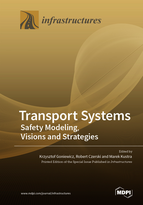Transport Systems: Safety Modeling, Visions and Strategies
A special issue of Infrastructures (ISSN 2412-3811).
Deadline for manuscript submissions: closed (30 September 2021) | Viewed by 29999
Special Issue Editors
Interests: crisis management; disaster management; disaster preparedness; disasters; safety; health security; CIMIC
Special Issues, Collections and Topics in MDPI journals
Interests: transportation; transport system; aviation safety
Special Issue Information
Dear Colleagues,
Transport, in general, is vital for the prosperity and functioning of society. To identify opportunities for future action, we must examine how transport grew and how problems became more pronounced.
This Special Issue will include papers describing the synthesis of current theory and practice of planning, design, operation, and safety of modern transport, with special focus on future visions and strategies of transport sustainability, which will be of interest to scientists dealing with transport problems and generally involved in traffic engineering as well as design, traffic networks, and maintenance engineers.
Other major areas of interest with regard to transport include but are not limited to:
- Sustainability interpretation in transport infrastructure
- Public transport systems
- Intelligent transport systems
- Transportation planning
- Road transport network
- Air transport industry
- Technical innovations
- Green transportation
I invite you to consider submitting your contribution to this important discussion. Together, we can move the discussion forward with our questions, challenges, and solutions.
Dr. Krzysztof GoniewiczDr. Robert Czerski
Dr. Marek Kustra
Guest Editors
Manuscript Submission Information
Manuscripts should be submitted online at www.mdpi.com by registering and logging in to this website. Once you are registered, click here to go to the submission form. Manuscripts can be submitted until the deadline. All submissions that pass pre-check are peer-reviewed. Accepted papers will be published continuously in the journal (as soon as accepted) and will be listed together on the special issue website. Research articles, review articles as well as short communications are invited. For planned papers, a title and short abstract (about 100 words) can be sent to the Editorial Office for announcement on this website.
Submitted manuscripts should not have been published previously, nor be under consideration for publication elsewhere (except conference proceedings papers). All manuscripts are thoroughly refereed through a single-blind peer-review process. A guide for authors and other relevant information for submission of manuscripts is available on the Instructions for Authors page. Infrastructures is an international peer-reviewed open access monthly journal published by MDPI.
Please visit the Instructions for Authors page before submitting a manuscript. The Article Processing Charge (APC) for publication in this open access journal is 1800 CHF (Swiss Francs). Submitted papers should be well formatted and use good English. Authors may use MDPI's English editing service prior to publication or during author revisions.
Keywords
- transport systems
- transport network
- sustainable development
- safety







